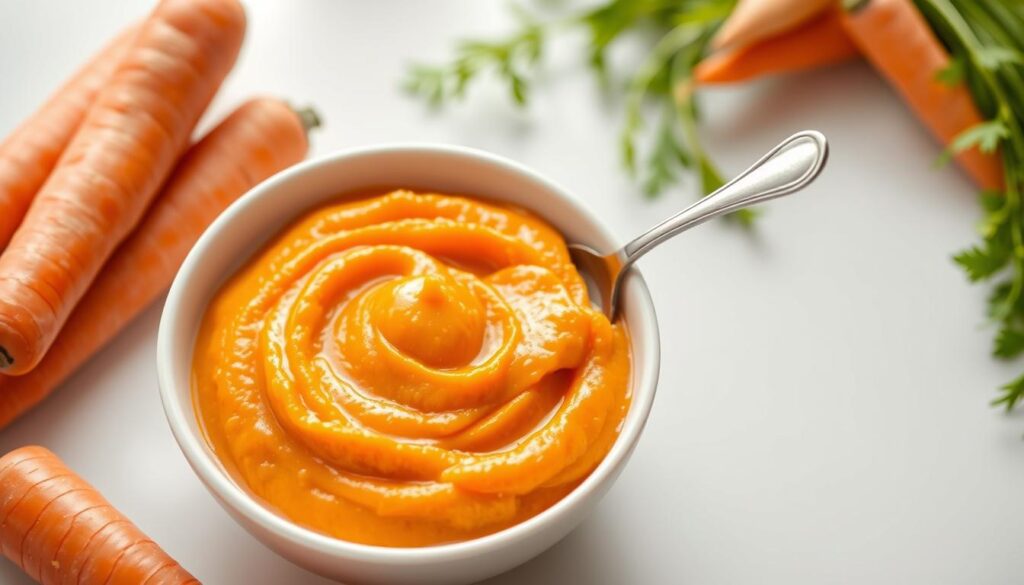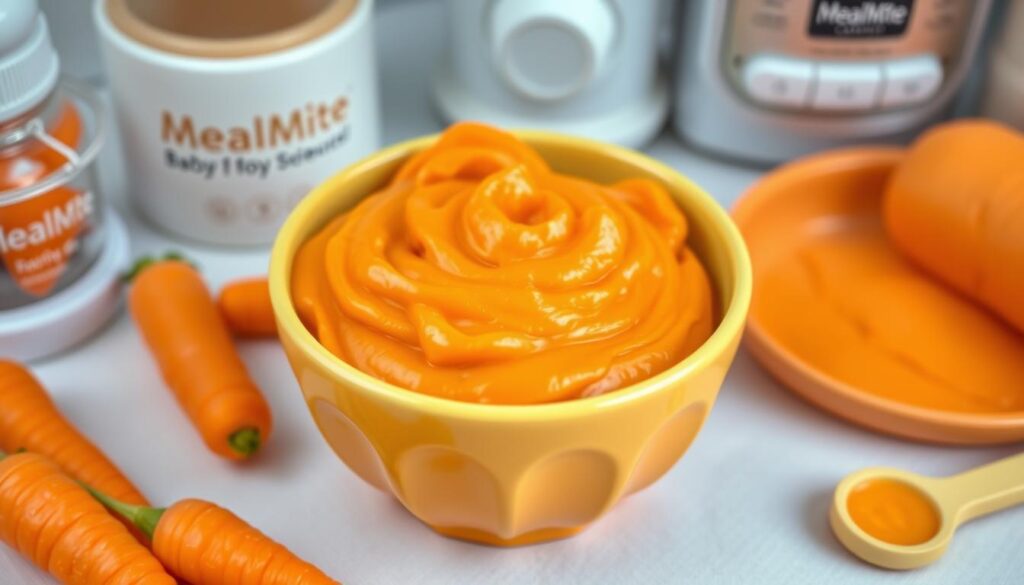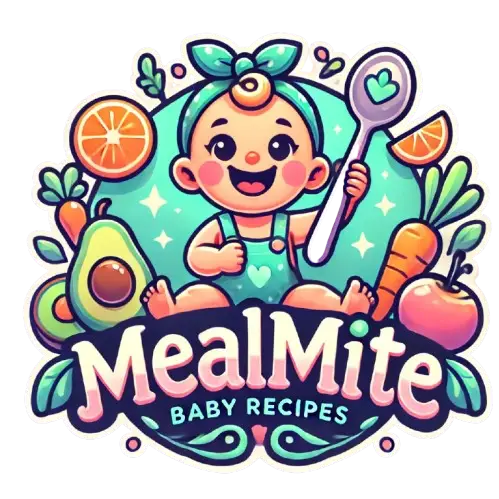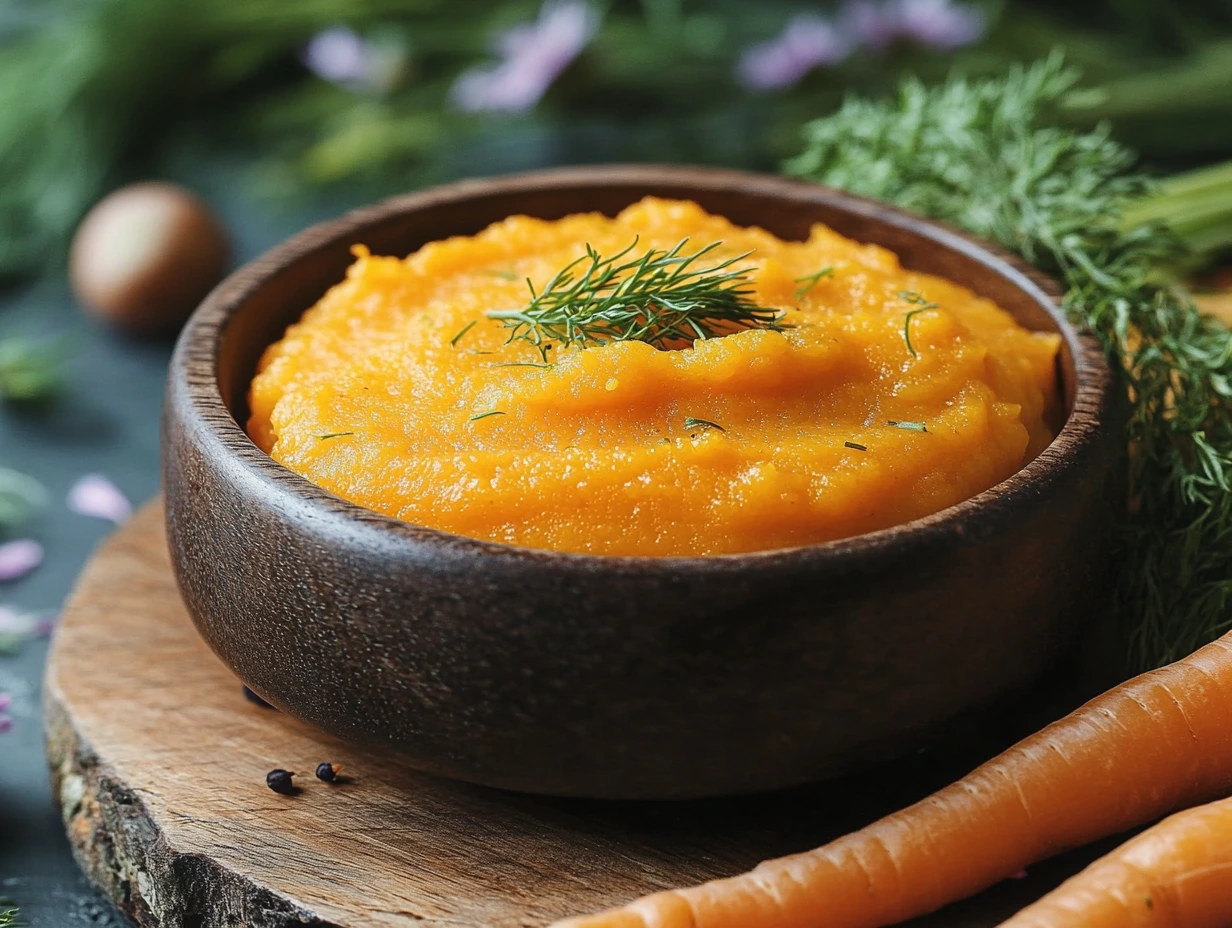As a parent, you want the best for your baby. A tasty carrot puree recipe is a great start. It’s easy to digest and packed with nutrients, perfect for your little one. This recipe helps your baby grow strong and healthy.
Table of Contents

Carrot puree is a simple and healthy choice for baby food. Just use fresh carrots and blend them with water or breast milk. It’s smooth and creamy, great for introducing new tastes and textures to your baby and toddler.
Key Takeaways
- You can make a delicious carrot puree recipe at home with minimal ingredients.
- Carrot puree is a great first food for babies because it’s easy to digest and nutrient-rich.
- A carrot puree recipe can suit your baby’s tastes and needs.
- Carrot puree can be stored in the fridge or freezer for later use, making it a convenient baby food option.
- Always check with your pediatrician before introducing new foods, including carrot puree, to your baby’s diet.
- A carrot puree recipe is a great way to introduce your baby to new flavors and textures.
- Carrot puree is a popular baby food because it’s easy to make and requires minimal ingredients.
Benefits of Homemade Carrot Puree for Your Baby
As a parent, you want the best for your baby. Making homemade carrot puree is a great choice. Carrots are full of vitamins and minerals, perfect for babies. This way, your baby gets the nutrients they need without preservatives or sugars.
Learning how to cook carrots for a baby is easy at home. Cooking and pureeing carrots make a healthy meal for your baby. Baby food carrots are packed with beta-carotene, which turns into vitamin A. Vitamin A is key for healthy vision, immune function, and skin.
Nutritional Value of Carrots for Infants
Carrots are full of nutrients good for babies. They’re rich in fiber, vitamin C, and vitamin K. These nutrients help with bowel movements and prevent constipation.

Why Homemade is Better Than Store-Bought
Homemade baby food lets you control what goes in. Homemade carrot puree has no preservatives or sugars. It’s also cheaper than store-bought, saving you up to 50%.
When to Introduce Carrot Puree to Your Baby
Introduce carrot puree to your baby at 4-6 months. Always check with your pediatrician before trying new foods. Start with a small amount and increase it as your baby gets used to it.
Essential Kitchen Tools for Making Baby Food
Preparing baby food carrots and other meals for your baby requires the right tools. A blender or food processor is key for making carrot puree recipe. Experts also suggest using a steamer basket for cooking carrots and veggies.
Having good knives and a veggie peeler can simplify food prep. A baby food maker is also a good investment for healthy meals. For serving, sectioned plates and reusable pouches are convenient.

Other useful items include a splat mat for easy cleanup and freezer trays for storing food. Baby wipes are handy for cleaning up spills. These tools make preparing carrot puree recipe and other baby foods easy and fun.
- Blender or food processor
- Steamer basket
- A good set of knives
- Veggie peeler
- Baby food maker
- Sectioned plates
- Reusable pouches
With these tools, you can make a variety of healthy baby food carrots and meals. It’s easy to introduce new foods and textures to your baby’s diet.
Selecting and Preparing Your Carrots
Choosing the right carrots is key for tasty baby carrot puree. Opt for fresh, organic whole carrots without pesticides. Peel and chop them before cooking to make the puree smooth and safe for your baby.
Start by washing the carrots well to get rid of dirt. Then, cut them into small pieces. Cook them in water until they’re soft. This step is important for how to cook carrots for baby, as it makes the nutrients easier to digest.
Here are some tips for preparing your carrots:
- Choose fresh, organic whole carrots
- Peel the carrots before chopping and cooking
- Wash the carrots thoroughly under running water
- Cook the carrots in a pot of water until they are tender
By following these steps, you can make a tasty and healthy baby food carrots puree. Always check the puree’s temperature before serving to your baby to avoid burns.
| Nutrient | Amount per serving |
|---|---|
| Calories | 21 |
| Carbohydrates | 5g |
| Protein | 0.5g |
| Total fat | 0.1g |
Simple Carrot Puree Recipe Step-by-Step
To make a tasty carrot puree for your baby, start by peeling and chopping 1 lb of carrots into 2-inch chunks. Put the carrot chunks in a steamer basket with 2 inches of water. Steam them for about 20 minutes, or until they’re soft enough to be pierced with a fork.
After that, blend the cooked carrots into a smooth puree. You can use a hand blender, blender, or food processor. Feel free to add a teaspoon of cumin or a tablespoon of grapeseed oil to make it more interesting for your baby.
Here is a summary of the nutritional information for this carrot puree recipe:
| Nutrient | Per Serving |
|---|---|
| Calories | 21 kcal |
| Carbohydrates | 3 g |
| Protein | 1 g |
| Fat | 1 g |
| Vitamin A | 5052 IU |
This carrot puree recipe yields 15 cubes of baby food. You can keep it in the fridge for up to 5 days or freeze it for up to 3 months. Serve it as a side dish or mix it with fruits or grains for more flavor.
Achieving the Perfect Consistency
When making baby food carrots, getting the right consistency is key. You can thin the puree with breast milk, formula, or water. This is vital when you first introduce carrot puree to your baby.
Think about your baby’s age and what they like. Younger babies might need a thinner mix, while older ones might like it thicker. Here are some tips to get it just right:
Adding Liquid Options
- Breast milk: adds natural sweetness and nutrients
- Formula: provides essential vitamins and minerals
- Water: helps to thin out the puree to the desired consistency
Texture Guidelines by Age
| Age | Consistency |
|---|---|
| 4-6 months | Thin, smooth puree |
| 7-9 months | Thicker, slightly chunky puree |
| 10-12 months | Thick, mashed carrots |
By following these tips and using the right liquids, you can make a tasty and healthy carrot puree for your baby. Always check with your pediatrician before adding new foods to your baby’s diet.
Storage and Reheating Guidelines
Storing and reheating your carrot puree recipe is key to keeping it safe and tasty. Experts say you can keep homemade carrot puree recipe in the fridge for 3 days. Or, you can freeze it for up to 3 months.
To keep your baby food fresh, use plastic tubs with tight lids or ice cube trays in freezer bags. When you reheat, make sure it’s steaming hot. Serving it warm or at room temperature is best after it cools a bit.
Here are some tips for storing and reheating your carrot puree recipe:
- Store in the fridge for up to 3 days
- Freeze for up to 3 months
- Reheat until steaming
- Serve warm or at room temperature
Always check the baby food temperature before serving. Never reheat it more than once. By following these tips, your carrot puree recipe will stay fresh and healthy for your baby.
Creative Ways to Serve Carrot Puree
When serving carrot puree to your baby, you can be creative. Mixing it with foods like apples or sweet potatoes adds flavor. It also gives your baby a variety of nutrients.
Learning to cook carrots for baby food is key. Carrots are nutritious and make great baby food. You can serve the puree warm or at room temperature, depending on your baby’s taste.
- Apples: Add a sweet touch to the puree by mixing it with apples.
- Sweet potatoes: Combine the puree with mashed sweet potatoes for a nutritious and filling meal.
- Chicken: Mix the puree with cooked, mashed chicken for a protein-rich meal.
Always check the food’s temperature before serving it to your baby. This ensures it’s not too hot. Being creative with carrot puree makes mealtime fun and nutritious for your baby.
| Food | Benefits |
|---|---|
| Carrot puree | Rich in vitamins and minerals |
| Apples | Good source of fiber and antioxidants |
| Sweet potatoes | Rich in vitamins A and C, and fiber |
Safety Precautions When Making Baby Food
When making your baby’s carrot puree, it’s key to follow safety steps. This ensures the food is safe and healthy for your baby. The biggest risk of nitrate poisoning is in babies under three months. This risk drops a lot after six months.
To make homemade baby food like carrot puree safely, keep your kitchen clean. Wash your hands well, clean all tools and surfaces, and store food in airtight containers. Keep these in the fridge or freezer.
Kitchen Hygiene Requirements
To cut down on contamination risks, do the following:
- Wash your hands with soap and water for at least 20 seconds before handling baby food
- Clean and sanitize all utensils, equipment, and surfaces that come into contact with the baby food
- Use separate cutting boards and utensils for raw and cooked foods
Food Safety Temperature Guidelines
Follow these temperature guidelines for storing and reheating baby food:
- Refrigerate perishable foods within 2 hours of preparation
- Freeze purees to slow down nitrate production and store them for up to 3-5 days
- Discard opened jars of commercial baby food after 24 hours
By sticking to these safety steps, you can make sure your baby’s carrot puree is safe and tasty. Always keep kitchen hygiene and food safety in mind. This helps avoid contamination and nitrate poisoning risks.
| Food Type | Storage Time |
|---|---|
| Homemade pureed baby food | 48-72 hours in the refrigerator |
| Opened commercial baby food | 24 hours |
| Frozen ground meat, poultry, fish, and shellfish | 2 days |
Troubleshooting Common Issues
When making baby food carrots, you might face some common problems. One big issue is getting the right texture and consistency. It’s key to know how to cook carrots for baby food correctly. If you overcook or undercook, the texture won’t be right.
Here are some tips to fix common issues with baby food carrots:
- Check the cooking time and temperature to make sure the carrots are just right.
- Use the right amount of liquid when pureeing the carrots for the perfect consistency.
- If the puree is too thick, add a bit of water or breast milk to thin it out.
By following these tips, you can make a tasty and healthy meal for your baby. Always put your baby’s safety and health first when making their food.
For more help on making baby food carrots and solving common problems, talk to your pediatrician or a healthcare expert. They can give you specific advice and help ensure your baby gets the nutrients they need.
| Common Issue | Solution |
|---|---|
| Texture and consistency problems | Adjust cooking time and temperature, use the right amount of liquid when pureeing |
| Undercooked or overcooked carrots | Check cooking time and temperature, adjust as needed |
| Puree is too thick or too thin | Add water or breast milk to thin out, or cook for a shorter time to thicken |
Conclusion: Starting Your Baby Food Journey
Starting your baby’s food journey with homemade carrot puree is a great choice. It’s packed with vitamins and fiber, which are good for their health. Making this simple recipe helps your baby develop healthy eating habits from the start.
Remember, introducing solid foods is a slow process. Be patient and watch for your baby’s signs. As they grow, you can add more food and try different tastes and textures. With the right tools, you can make many healthy meals for your baby.
FAQ
What are the benefits of homemade carrot puree for my baby?
Homemade carrot puree is great for babies. It’s full of vitamins and minerals. This makes it a top choice for their first foods.
When should I introduce carrot puree to my baby?
We’ll talk about when to start carrot puree with your baby. You’ll get advice on the best time.
What kitchen tools do I need to make carrot puree?
Making carrot puree needs a few tools. You’ll need a blender or food processor and a steamer basket. We’ll cover what tools you need and how to pick the right ones.
How do I select and prepare the best carrots for making puree?
Choosing the right carrots is key for tasty puree. We’ll guide you on picking the best carrots. Plus, we’ll share tips on washing and cutting them.
What is the step-by-step process for making carrot puree?
We have a simple recipe for carrot puree. It’s easy to follow and needs just a few ingredients.
How can I achieve the perfect consistency for my baby’s carrot puree?
Getting the right consistency is important. We’ll show you how to adjust the liquid and texture. This ensures your baby enjoys their puree.
How should I store and reheat the carrot puree?
Storing and reheating puree correctly is vital. We’ll give you tips on how to keep it fresh and safe for your baby.
How can I serve carrot puree in creative and fun ways?
Serving carrot puree can be fun. We’ll share ideas on mixing it with other foods. Plus, we’ll talk about serving temperatures to keep meals exciting.
What safety precautions should I take when making baby food?
Safety is crucial when making baby food. We’ll cover kitchen hygiene and temperature guidelines. This ensures your baby’s puree is safe and healthy.
How can I troubleshoot common issues with carrot puree?
Dealing with common issues in carrot puree can be tricky. We’ll help with texture and consistency problems. Plus, we’ll offer tips for other common issues.


3 thoughts on “Delicious Carrot Puree Recipe – Perfect for Babies & Toddlers”